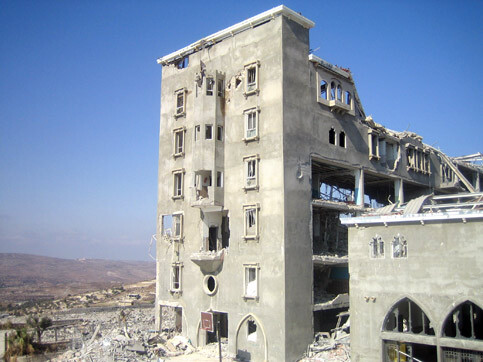IRIN 30 August 2006

One of the nine schools in Bint Jbeil that were either totally or partially destroyed. (Serene Assir/IRIN)
BINT JBEIL/BEIRUT - Sitting on the pavement by a shattered building that once housed a government school near the main square in Bint Jbeil, 100 km south of Beirut, eight-year-old Fatme talked about school life prior to the war.
“I love drawing, and maths. They are my favourite subjects,” she said. “Now, both my brother’s school and mine have been destroyed. We don’t know if we’ll be able to go to school this year. If we don’t, I’ll get bored and sad.”
With an estimated pre-war population of 30,000 people, Bint Jbeil witnessed some of the heaviest bombing by Israel in addition to extensive ground battles with the armed wing of Hezbollah, a Lebanese political party.
Over the course of the 34-day conflict between Israel and Hezbollah, all of Bint Jbeil’s 30,000 residents fled to other areas. According to town residents, many have not yet returned, as their homes were totally wrecked.
The United Nations Office for the Coordination of Humanitarian Affairs (OCHA) estimated that 1,200 houses out of 1,500 in Bint Jbeil were destroyed.
Residents of Bint Jbeil say that all nine schools in their town were either destroyed or damaged.
School destruction
According to the Lebanese government, the country’s education sector has suffered US $70 million in damages to infrastructure, supplies and equipment.
In an exclusive interview with IRIN, education minister Khaled Qabbani said approximately 50 schools, including 13 public schools, across the country were totally destroyed.
Much of the damage was in southern Lebanon, where bombing and fighting were heaviest. “In the south alone, between 275 and 300 [schools] suffered damages from nearby bombings,” Qabbani said.
Kamel Mehanna, president of Beirut-based NGO Amel Association, says a full assessment of damage to infrastructure remains incomplete because of a continued Israeli presence in some areas of the south. “There are nine areas which we remain unable to assess for damages,” said Mehanna.
The government is working in collaboration with the UN Children’s Fund (Unicef) and the UN’s Education, Scientific and Cultural Organisation (UNESCO) to ensure that all children across the south attend school by the newly revised national school start date of 9 October - three weeks later than the norm.
In the south, in towns and villages where school buildings were rendered unusable by Israeli bombing, there are plans to set up and use prefabricated buildings while the reconstruction and rehabilitation of destroyed schools gets underway.
“With the collaboration of the international donor community, we will set up prefabricated buildings to house temporary schools in areas like Bint Jbeil,” said Qabbani.
Alternatively, children will be able to attend schools in nearby towns if those in their local areas have been destroyed. “There are plans to set up a system whereby a single school can act as two, with two sets of children attending school in the morning and afternoon alternately,” Qabbani added.
However, there is some scepticism as to the government’s capacity to fulfil its pledge. “We have been contacting the education ministry to find out how we can help setting up prefabricated buildings,” said Yehia Raad, deputy head of the government’s Higher Relief Council. “As yet, we have received no precise instructions.”
“Even for those families who have returned, it is difficult to imagine how our children will go to school this year,” said Fatme’s grandmother as she walked towards an aid convoy arriving in her town. “There is nothing left here.”
Related Links